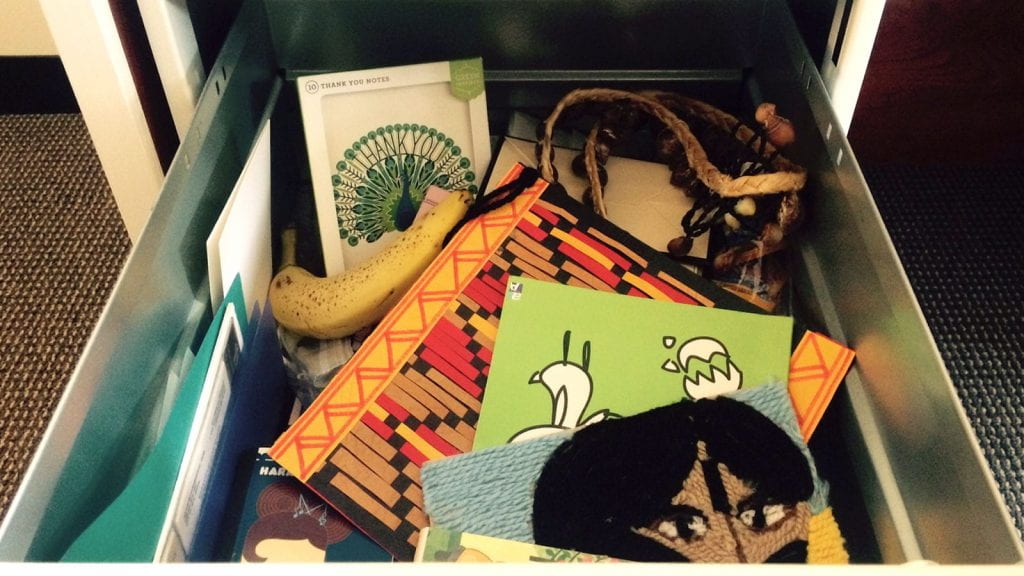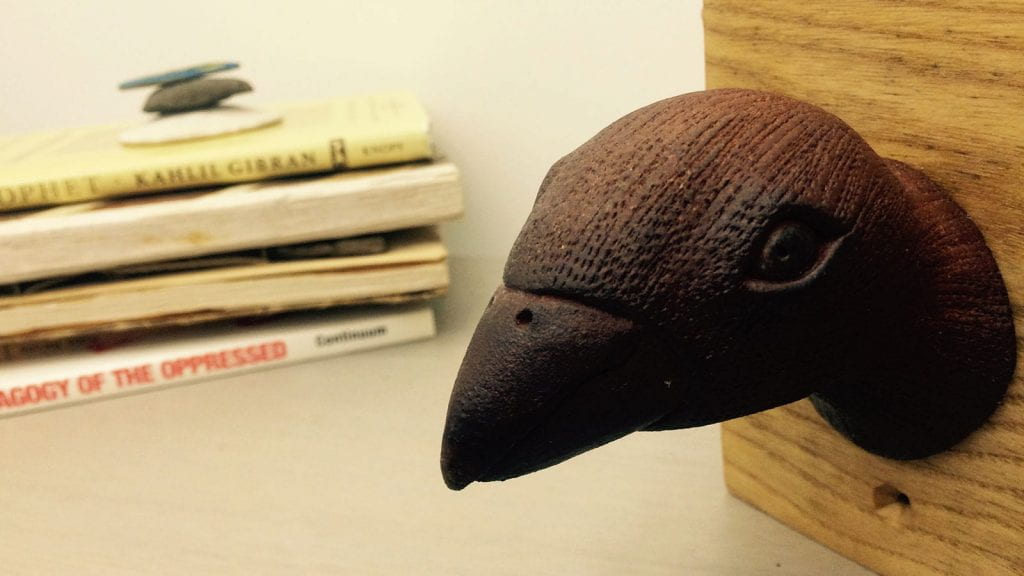Christine Yeh, Professor of Education and Psychology, considers the objects, notes, and items in her office and how the clutter reveals special relationships and different kinds of hidden and unfinished stories.

In my desk, I have a catchall drawer with a random collection of objects, some necessary—a pair of black shoes, bags of “healthy” snacks—and others perhaps confusing things—a small hand-carved boat from Samoa, a marble from El Salvador, and an intricate weaving made of scrap paper and yarn. These “confusing” and rather unacademic items each have a story connected to it, but I often wonder if I have gone too far in contributing to the chaos of my daily life.
When I moved into a new office last summer, I seized the opportunity to purge my space of boxes of forgotten files, old data, and things that do not fit into any obvious work related category (think a pile of heart shaped rocks in a bowl). I Googled photos of “Zen office spaces” and studied Marie Kondo’s book The Life-Changing Magic of Tidying Up: The Japanese Art of Decluttering and Organizing and paid particular attention to her thoughts on office cleaning. She offered the following insights and directions on how to create a space free of clutter:
- Hold each book in your hand, and if it gives you a thrill of pleasure when you touch it, keep it. Otherwise, it must go.
- If you think you’ll read a book “one day,” discard it.
- If an item doesn’t spark joy for you, but is necessary to get work done, you may keep it.
- Discard all paper unless in use, is needed for a limited period of time, or must be kept indefinitely.
I contemplated the hundreds of pages and papers that could justifiably be recycled according to her rules. These included my 9 years of ideas brainstorms, and sketches kept in colorful Japanese notebooks, ethnographic notes and memos from my international research travel journals, and personally revealing artwork from past students exploring their identities and culture on paper. My most meaningful keepsake is the partially completed picture book drawn on scrap paper by a 5th grade boy in Western Samoa, depicting the story of how he lost his family in the 2010 tsunami. He gave me this precious book because I was the first person in more than a year to ask him to share his story. He left the last few pages blank—unfinished—because his future was still unsure.
As I inspected my belongings, I realized that much of my clutter included different kinds of unfinished stories—blank pages that serve as a reminder of the work that is yet to be done, experienced, or imagined. My scribbles and sketches comprise urgent notes to self, fights I have yet to fight, and emotional rants about inequity that hold me accountable. I also wondered if I am particularly drawn to works in progress rather than the finished, printed, or framed final pieces as they are glimpses of the creative process and moments of possibilities. Where do these unfinished, incomplete, in progress stories, doodles, and projects fit into Kondo’s rules about what to keep?
I could also not let go of many objects in my secret drawer because they are symbols of connections I have made that inspire me to be the best version of my self. I find these items are especially grounding when I am feeling overwhelmed by the busy work of academia. It occurred to me that perhaps in our creative and scholarly work, our criteria for what to keep and what to toss includes Kondo’s ideas but may extend beyond whether or not an object “sparks joy” or has use and I came up with my own guiding questions for creating an inspiring office space.
- Does the object inspire you?
- Does it tell part of an important story in your history?
- Does it symbolize a critical aspect of your multiple identities?
- Does it highlight a journey or process you are experiencing?
- Does it serve as a reminder of your vision for your work?
When I began cleansing my office according to Kondo’s rule, I picked up each book to see if it would “spark joy” as she requires in her philosophy. But as I held each book, joy was not the predominant feeling. Rather, I thought about the books that were difficult, intense, and heart-wrenching. These were books that were painfully transformative in my thinking about justice. Seeing these books on my shelf (organized by color to spark joy) provided historical evidence of my evolving identity as a researcher. As I flipped through the pages, I was reminded of why I entered academia in the first place. I was reminded of conversations I had with friends and colleagues. I contemplated and grappled with ideas about equity, and I felt deeply inspired.
I also tried to organize my papers and notebooks using my new rules around organizing for inspiration. I appreciated reading through pages of my writing in notebooks –snapshots of urgent ideas and passions for my work. Sadly, many of these reflections and raw emotions remain hidden in these journals as they are regularly deleted from my manuscripts by journal editors during the review process because they are not seen as “scholarly.” Keeping them nearby feels refreshingly humanizing as they hold me accountable to my vision and to the communities I partner with.

Photo credit: Estella Pabonan
Kondo believes that if something does not spark joy, then you must get rid of it. Similarly, I repeatedly asked myself, “Does this inspire me?” as I went through each object in my cluttered space. Finding inspiration is unique to the individual, but I did find that the guiding questions I listed above helped me make decisions about what to cleanse. For example, the art featured in my office are mostly photographs, paintings, drawings, and sculptures from people I am close to—a prehistoric wood-fired stoneware bird head mounted on a thick piece of oak wood envisioned and created by a potter friend? Definitely keep. Scribbled note in Chinese from a second grade student I taught in Nan’ao village in Taiwan? Keep. Old handouts from meetings, workshops, and schedules? Recycle.
Though the heart of my research is outside of my office and in local and international communities, I find I need to be very intentional about creating a space at work that attempts to reflect the collective voice of these relationships. After many iterations and attempts at office organization, I may not have achieved the sparse Zen office I originally thought I wanted, but I feel I have created a space of experimentation and inspiration. Like the blank pages of my precious picture book from Samoa, this new space has an openness to the possible stories that are yet to come.
I love this post as I’m always battling clutter. To be honest, a lot of my clutter is nothing meaningful, just random odds and ends that seem to gather on my dining room table on a daily basis. I tend to let it pile up, then scoop it all into a box when someone’s coming over, with the promise that I’ll sort through it later. But I also have inordinate amounts of sentimental stuff that I can’t manage to part with. I have a china cabinet full of my kids’ clay pinch pots and bins and bins of their paintings and drawings. And then there are the outgrown toys. Massive collections of Playmobil and Thomas trains lurk in my basement and attic while I ponder whether to save them for potential grandchildren. Your limited collection of carefully curated meaningful items is an inspiration! Did you consciously choose to keep just one thing of each type? Have you managed to implement the same approach at home? Perhaps I’ll take another stab at the clutter this weekend.
I love the idea of our office spaces reflecting the way that our work is always in progress. You are so on point about finding ways to be inspired–in spite of the sterile tendencies of academic writing and peer review–through memories of the meaningful stories and relationships that research entails.
Thank you for sharing this. I am going to use your list as I re-claim my office!
Tanya, Thank you for the comment. For some reason, organizing at home was really easy with Marie Kondo’s Konmari method. She basically recommends that you put everything in one category together, go through each item one by one and assess whether or not the item “sparks joy”. Some sentimental items will do this and others you may be keeping out of obligation. Only keep those that spark joy. This is much easier for the useless items you mention (as well as the nice toys). The harder issue for me was for items that were not about joy but about inspiration or transformation which was related to my work in communities. For these items, I did not keep things based on category but based on meaningfulness (to the questions I asked myself above). Based on this, I was able to unload more than 15 boxes from my office and am surrounded by the most inspirational things from my work. Thanks and good luck!
This blog is a timely one for me, as I continue to de-clutter my home office, which ended being a dumping ground for all of my books and papers, and my work office, which I am decorating and putting together after moving in this summer. I agree with you that I tend to extend Marie Kondo’s idea of “joy” to strong emotions felt to move me in the direction I want to go both personally and professionally. This may also be related to the fact that many of the books that I own discuss issues of racism, discrimination, oppression, and coping. There is something magical about loving the place we work in, the space that inspire creativity, and nurture the process of telling the truth. Thank you for sharing your journey of de-cluttering and making meaningful decisions of items around you. I am inspired to continue my process!
Thank you Christine, for this wonderful blog, full of inspiration, and very timely for me.
I appreciate thinking about items in our offices that inspire us, and also having room for ongoing reflection for persistence and change in what we do.
Christine, I really enjoyed reading this blog as making sense of my clutter is an ongoing process for me. I really appreciated your guiding questions and most especially “Does it symbolize a critical aspect of your multiple identities?” Thanks for the inspiration!
Somehow I discovered your blog by accident, but what a wonderful bit of serendipity! I have been an avid hoarder for many years, and now find myself with probably 150 bankers boxes of old papers, correspondence, keepsakes, etc. The Kondo book opened my eyes! And your personal experience as an academic and scholar and person with a keen sense of social justice has also given me a push in the direction of downsizing and decluttering and creating a space that is meaningful and joyful and significant. Thank you for sharing this wonderful post about your own journey through “clutter” and your own discovery of “importance” and “symbolism” as you let things “go.” Uldis Kruze